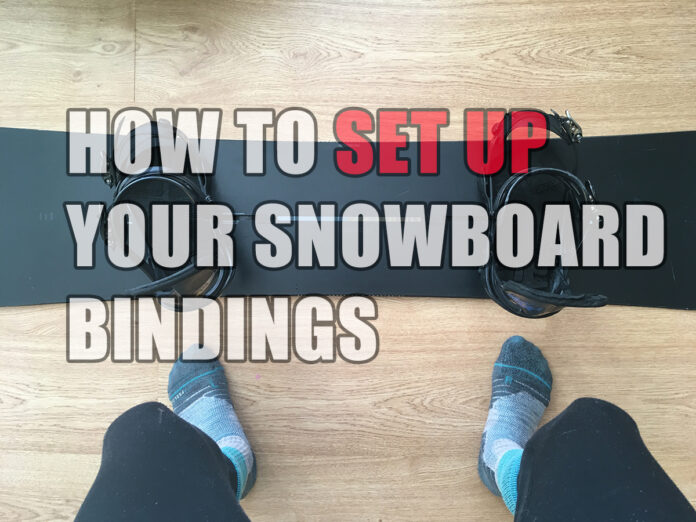
Determining the stance width and angles to setup for a snowboard is something that makes me think no matter how many years I’ve been
snowboarding. Snowboard beginners don’t know what width and angle to ride at all, so they’re usually assisted by the clerks at the shop.
If you ask a shop clerk who is familiar with snowboarding, you should get some good advice. However, I would like to be careful because snowboards purchased secondhand/from garage sales may be attached at a ridiculous stance angle.
What do you have to say about the correct stance width and angle to use for snowboard riding?
I will introduce how to determine the correct stance width and angles via trial and error & some images below.
目次
- Stance width and angles do not exist in skating and surfing
- Let’s consider the stance width and stance angle via the elimination method with an extreme stance.
- Consider the elements of snowboarder movement and consider the stance width and stance angle.
- What is the stance angle based on 0 degrees?
- Why Duck Stance became mainstream
- Harmful effects of sideways stance
- My conclusion is Duck Stance Recommended
- It’s a good idea to actually wear boots to set your stance!
- Recommended Stance Angles for Different Snowboarding Styles
- Let’s refer to the stance width and angle of professional snowboarders around the world!
Stance width and angles do not exist in skating and surfing
What is the biggest difference between different board riding sports such as skateboarding, surfing and snowboarding?
Only snowboards have a device called a binding which secures your feet in place. Equally, it means that the stance width and angle are decided in advance and cant be adjusted during riding.
For skating and surfing, I usually decide the stance width and angle with my own gut feeling. Furthermore, depending on the situation, we can respond by moving our legs and adjust the angle/binding angles while we are riding.
Unlike snowboarders, there is no need to finely adjust the angle or width of the fasteners. As you continue riding through the day, your own stance will be decided/adjusted to suit your comfort level.
If you are a snowboarder, you have to keep in a fixed stance as long as you have a binding, which is a foot (boot) fastener. The board and you are attached as one unit. Therefore, it is necessary to think more deeply about the width and angle of the stance. If you don’t snowboard in a setting that suits you, it can hinder your progress.
(Skating and surfing can change stance depending on the situation, but snowboarding cannot be changed while riding once it is decided.)
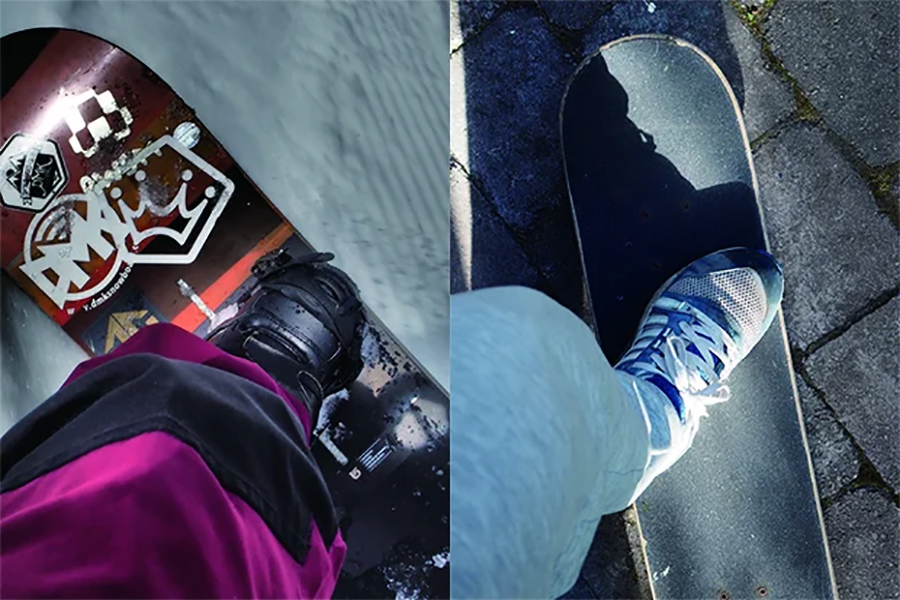
Let’s consider the stance width and stance angle via the elimination method with an extreme stance.
What should I have to do to decide on the snowboard binding settings (stance width, angle)?
Snowboarders need a lot of movement while riding.
It may be edging motion or a rotational motion that allows you to move the snowboard from heel side to toe side/vice versa.
However, the most basic movement you do on the snowboard is probably the crouching motion . To put it more simply, the exercise of squatting and standing up. It is the action of bending your knees and standing up straight.
Then, how easy is it to squat and stretch out your knees?
Let’s consider a very extreme example.
First, try to bend down and squat down while your legs are positioned narrower than your shoulder width.
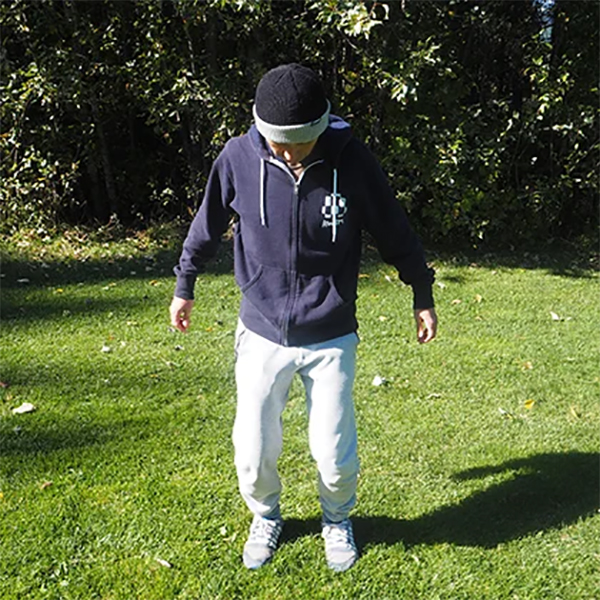
→ It’s hard to do. There should be an advantage to put the center of gravity over the center of the board…
Next, try to squat down while in a stance much wider than your shoulder width.

→ Its possible to squat down, but it feels like a sumo wrestler and is tiring to hold this squat.
After all, it seems that the shoulder width stance fits nicely.

Guess → Shoulder width seems to be the best!
Now, let’s squat with the tips of both feet facing straight ahead perpendicular to the nose/tail of the snowboard.

→ This feels cramped. It is difficult to bend and stretch out your knees.
Next, let’s open outwards the angle of both feet by about 45 degrees.

→ Well, this is possible… but I feel like I’m using a lot of strength when I bend my knees. I don’t think I can snowboard in such a crab position.
What we can see from the above experiments is that an approximate shoulder width is good for the stance width. It would be preferable that the stance angle is also moderately outward.
Of course, each person is unique and has different length joints, so it is not an unconditional rule, but we can imagine the correct stance width and angle to some extent.
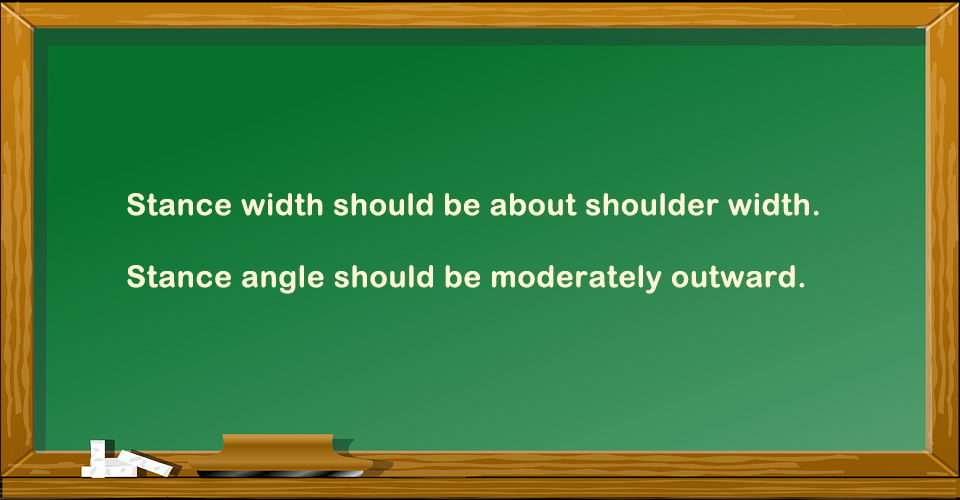
Consider the elements of snowboarder movement and consider the stance width and stance angle.
Consider the movement of the snowboard and think more deeply about the stance width and angle.
First of all, the ease of bending your knees that was the previous theme.
Furthermore, consider the three elements of board turning and edging.
1) Consider the ease of squatting. (Weighting your board, unloading your board)
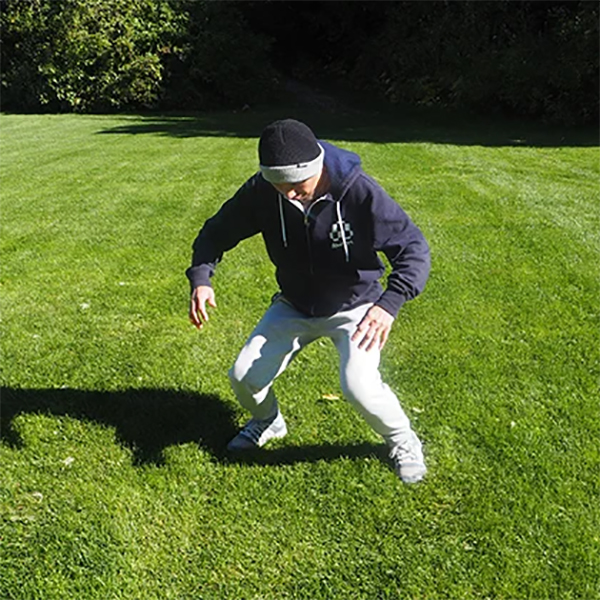
2) Consider the ease of rotating your body left/right. (rotational motion)

3) Consider whether it is easy to tip your snowboard and balance on the toe side and heel side of your snowboard. (edging)
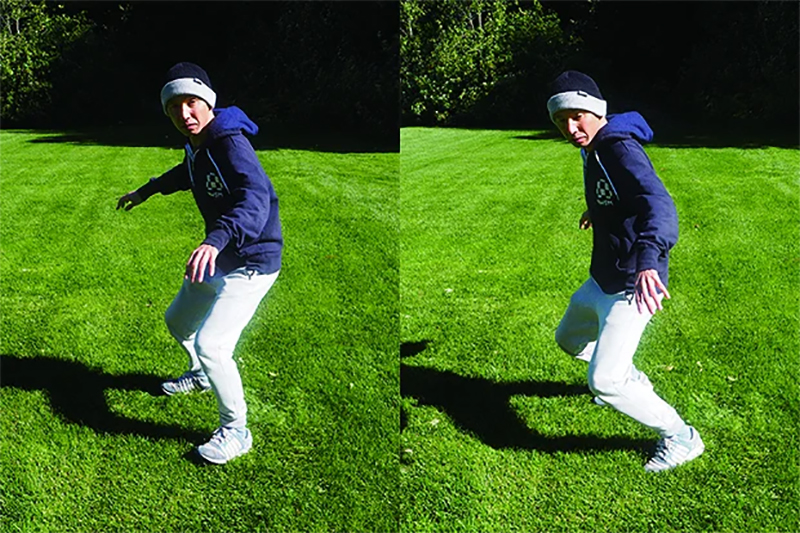
Considering the above factors, the stance width should be slightly wider than the shoulder width.
From the stance width considered earlier, the stance width will be slightly wider by a few centimeters then your shoulders(2 cm to 6 cm).
Since the board has its own weight, you can imagine that it would be better to have a slightly wider stance to rotate the board around.
Ultimately, if you have a magical board that weighs 0 kg, the stance width is probably just a stance width that makes it easy to bend your knees.
Also, regarding the stance angle, it is preferable that the toes of both feet face slightly outward.
Of course, there will be individual differences in the skeleton, but many people will feel that way.

What is the stance angle based on 0 degrees?
If you often look at websites such as snowboard magazines and snowboard makers, you will find stance information.
For example, “f15 b-12”.
But if a snowboard beginner looks at this, it seems like a mathematical formula or something, doesn’t it?
Do beginners really know this terminology? I am worried.
F means front, that is, front.
B means back, that is, behind.
On this DMKsnowboard.com site, it is a little easier to understand, such as 18 degrees before and -9 degrees after.
But there is one question I have. Do you really understand this for beginners? When. What does the angle of 0 degrees in the first place?
So take a look at the pictures below!

This is the board I’m using, but the front foot (left) is 18 degrees and the rear foot (right) is -12 degrees. By the way, the stance width is 56 cm. (* I tried to make 2021-2022 54 cm this season.)
0 degrees in the stance angle of the snowboard means to put it perpendicular the direction of travel of the board.
What is the angle at which the binding is tilted in the direction of travel of the board from there? The display is “F” or “front” or, “front foot”.
In my case (pictured below), it is 18 degrees to the front.
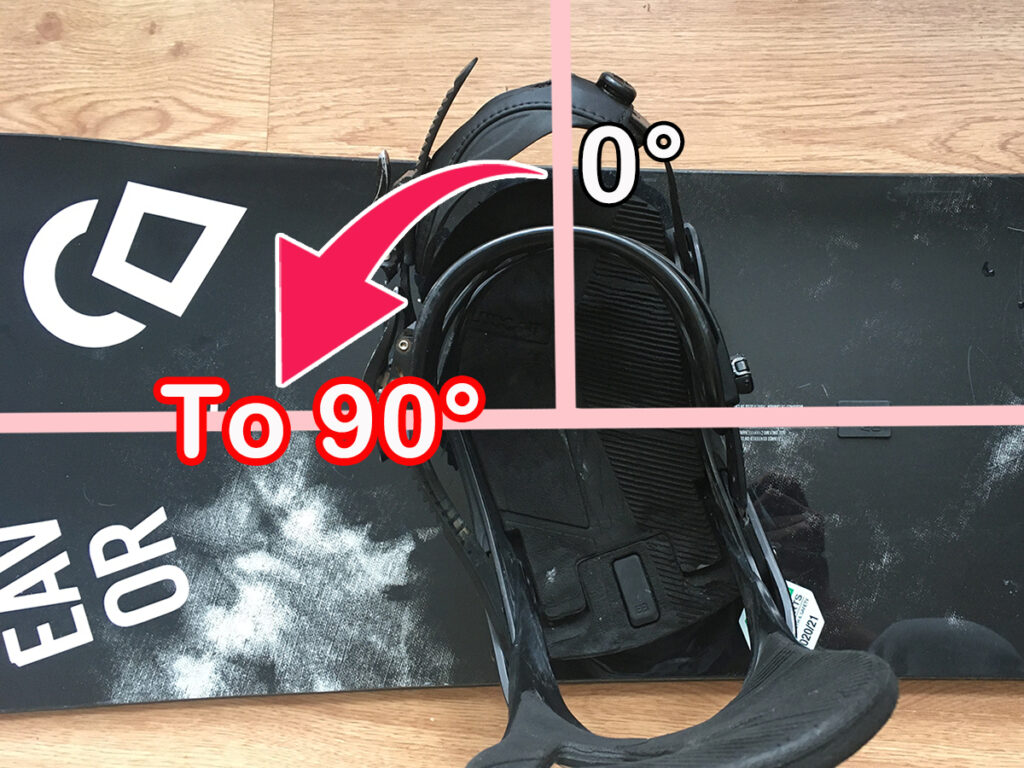
The structure is somewhat different depending on the binding manufacturer, but if you remove the base part as shown in the picture below, you can now see the display so that you can see what the angle of your binding is.
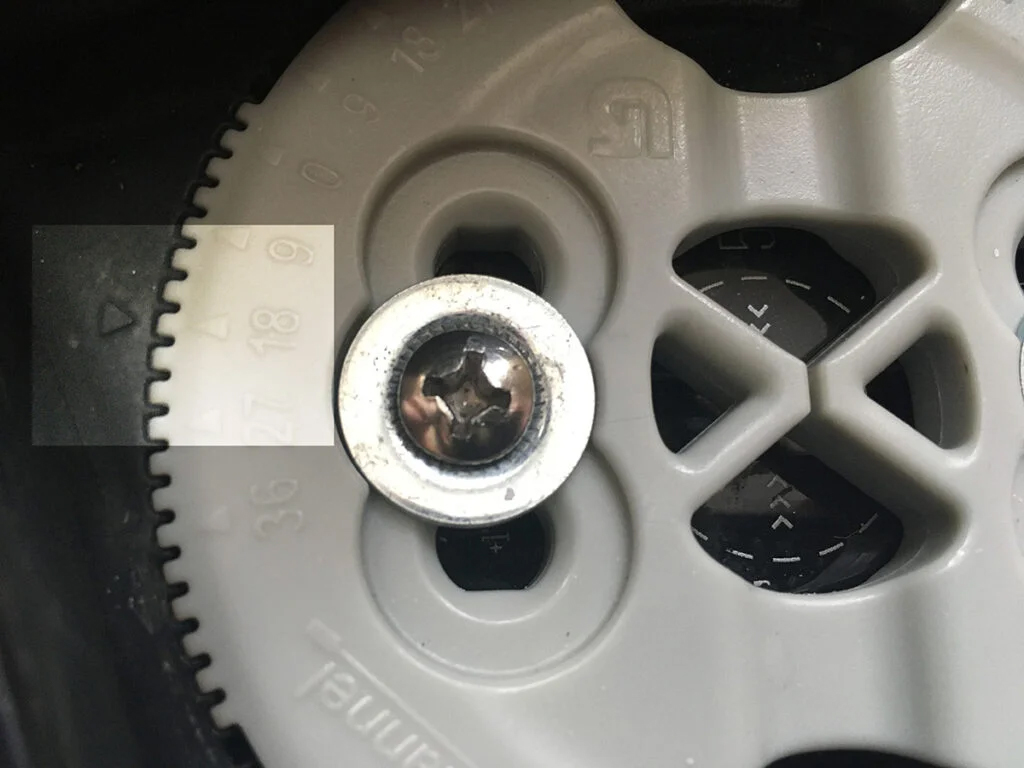
What is a popular angle for the front foot?
So at what angle do many snowboarders strap in for their front foot?
I haven’t checked the angles of all snowboarders, so it’s difficult to judge, but I think it’s almost like this.
The angle of the front foot is
24 degrees or more: This is quite rare and used for aggressive carving.
18 to 21 degrees: Popular. Recommended for those who enjoy free riding.
12 to 15 degrees: This is also a very popular angle. Freeride, freestyle intermediate angle.
6-9 degrees: Many angles for freestylers. Especially for professional riders, it is an angle that is quite common.
5 degrees or less: Equivalently rare. I haven’t heard many snowboarders using this angle.
A stance for back legs
Next, the story of the display of minus on the back foot.
This is called a duck stance, and if the back leg angles are facing outward to the tail of the snowboard (tail side), it will be displayed as a minus.
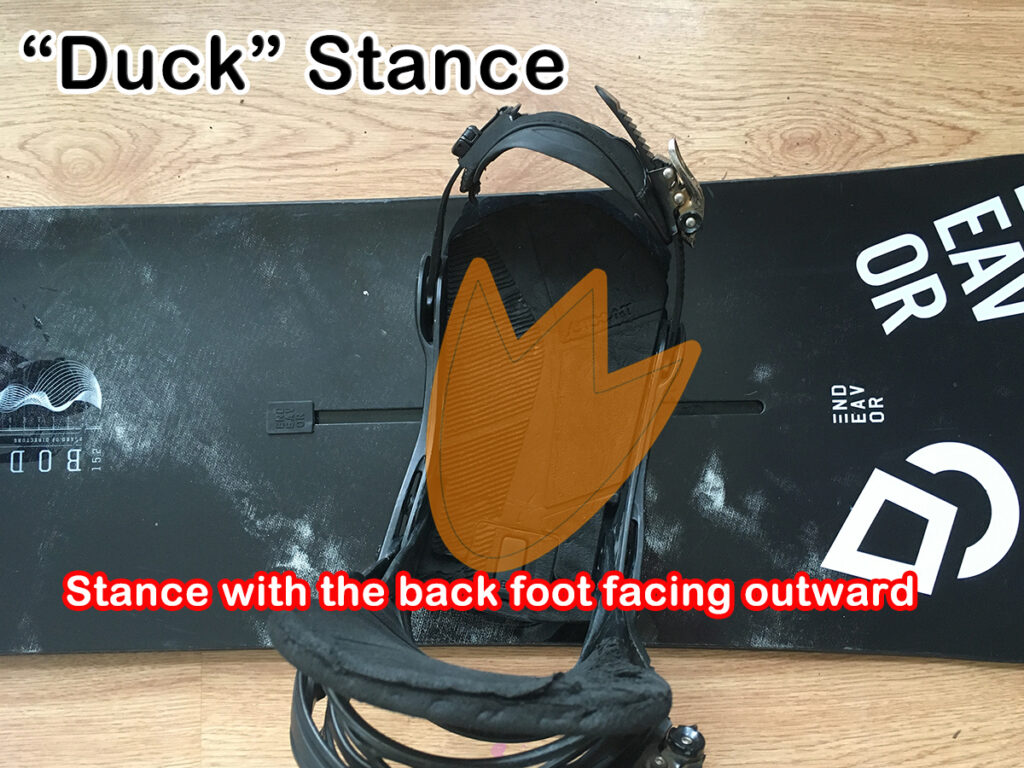
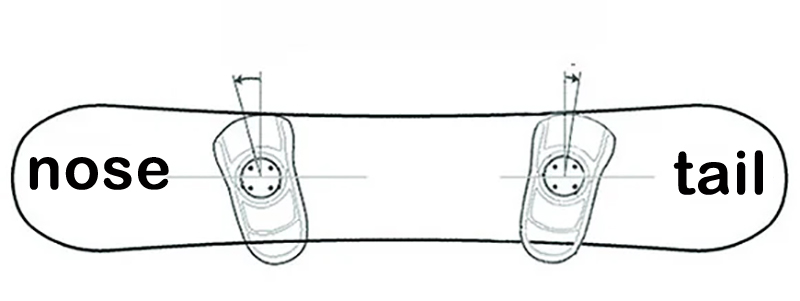
As you can see in the illustration, the duck stance is getting more popular in the current snowboard settings.
The illustration above shows that the front legs are 18 degrees and the rear legs are -9 degrees.
Many snowboarders are now snowboarding in this stance.
About the stance that a few riders use back foot angles that are positive

In the picture above, if it is tilted to the left, it will be a plus display. (* At first glance, the binding seems to be at 0 angle, but it is slightly angled to the nose of the snowboard by about 9 degrees.)
In other words, the angle of the back leg is positive if it is facing the direction of travel, and negative if it is facing backward. ..
However, in the case of a plus, we do not dare to add a (+) mark. When it is negative, I always add (-).
By the way, the number of people who set both their front and back legs to plus(+) is decreasing.
Twenty-five years ago, when I was selling snowboards at a snowboard shop, it was quite popular with 24 for front leg and 9 degrees for the back leg.
In the old-fashioned stance, when you stand with both feet in a positive angle stance, your hips naturally turn to the front, and the left-right balance with respect to the direction of travel of the board is much better. But now, when I recommend this kind of stance, I’m starting to feel this is more for carving warrior type, border cross, or alpine snowboarders.
What is the popular angle of the back legs?
The popular angle of the back legs is like this.
-18 degrees or higher: Not so much, but it’s not strange.
-12 to -15 degrees: Is it reasonably high? If you do freestyle, it will be easier to handle switch riding (reverse direction).
-6 degrees to -9 degrees: This is quite common! An angle that makes it easy to stand with a natural stance that does not go against the skeleton. Popular with freestylers!
0 to -5 degrees: Especially for those who enjoy free riding.
Plus angle: Recommended for those who want high-speed carving without doing too much switch!
Why Duck Stance became mainstream
During the early 90’s snowboard bubble era, many snowboard shops recommended customers to set their stance angle to +30 degrees front foot and +10 degrees for back foot.
As the times change, the angle of the front foot becomes 21 degrees and the angle of the back foot becomes 9 degrees. (Note: The stance angle is divided by 3 because the gauge that determines the stance angle is 3 degrees per dial change. Even now, there are many bindings that can only be done in 3 degree increments.)
And now, the stance angle is 18 degrees for the front legs and minus 9 degrees for the rear legs.
Why did duck stance become mainstream?
Reason for duck stance ①Because it is a natural stance
I think duck stance was a natural stance for the human skeleton in the first place.
The angle difference between the front foot and the back foot is not large (= almost similar angle). On top of that, the stance that the angle of the forefoot is slightly easier to move forward makes it easier to bend your knees and stretch the knees. This is the most natural stance for snowboarders.
Reason for duck stance ②From the idea that switch riding is important
Snowboards can ride in both directions.
This kind of snowboarding using the tail of the snowboard is called switch riding and it is easier to ride switch with a duck stance.
Being able to ride switch for snowboarders also broadens the range of techniques.
For example, you can do a 180 rotation when jumping and ride off in the opposite direction.
It also leads to the trick of starting off in switch, and doing a 180 degree rotation and riding off in your regular stance.
In addition, learning to ride switch will improve your balance as a snowboarder, so switch is a very important technique.
Nowadays, some snowboarders are putting a higher angle on their back foot to make switch riding easier for them.
This is a tricky thing, but I also snowboarded with a stance of 9 degrees front foot and -15 degrees for back foot, it felt like a goofy stance, but I was surprised that the switch riding was very easy to do.
I didn’t feel that this reverse stance would hinder riding when I’m in my regular stance.
Therefore, some snowboarders at the national team level dare to take such a reverse stance.
Harmful effects of sideways stance
If you stand naturally in the mainstream stance I’ve introduced so far, that is, in many snowboarder settings now, it is true that such a posture is easy to bend your knees, but it becomes unbalanced with respect to the direction of travel of the board. That is the harmful effect of the sideways stance.
This natural sideways posture is how beginners are usually taught in snowboarding, but some people recommend a stance that turns your upper body in the direction of travel.
In an extreme story, some demonstrations have 45 degrees front foot and 35 degrees for back boot.
This will make your body more squared and more balanced in the direction of travel.
Of course, switch riding will be a lot trickier.
You will also need leg strength as you are more likely to put weight on your back leg when riding with this stance.
However, if the front foot is 24 degrees and the back leg is 12 degrees, which was popular before, it can be said that it is the best posture for beginners because it is easy to turn the upper body forward while being almost sideways.
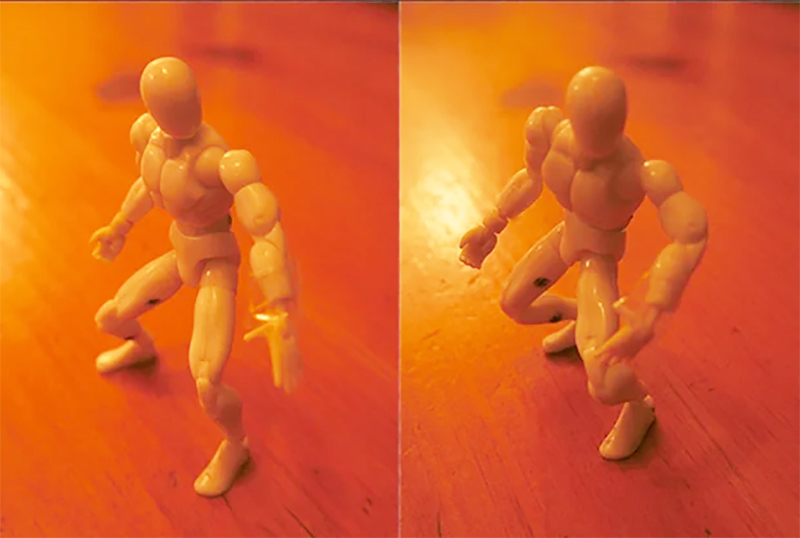
My conclusion is Duck Stance Recommended
I think it’s a way of thinking/different school of thought.
Anyway, if you want to teach beginners how to turn quickly, it may be better to have an open stance, a front foot of 24 degrees, and a rear foot of 9 degrees. I think that such a stance angle is also good for remembering how to turn for beginners and lets them get started making turns.
However, even beginner snowboarders will eventually want to learn switch, and I also want them to try the terrain park and enjoy freestyle snowboarding. And above all, I want you to ride in a natural posture with respect to the skeleton, so I recommend a stance such as 18 degrees front foot and minus 9 degrees for back foot as introduced earlier.
Of course, that’s my way of thinking, and I understand that other snowboard instructors have different ways of thinking … ..
It’s also true that in Canada, many people think like me.
Also, many riders in the snowboarding world are now snowboarding in this stance.
Do you have a snowboard hero/snowboard rider you admire a lot? You might want to copy his/her binding angles.
If you come this far, choosing your angles/width may be like a religious view. Who will be the guru!?
The story is a little off-topic, but what I wanted to convey is what happens when you widen or narrow your stance? What happens when you change the angle? In fact, at what angle do many snowboarders slide? To tell that.
I wanted to show you that kind of thing, so I introduced the theme of stance width and angle this time.
The answer is different for each, so I want you to decide the rest.
By the way, in my experience, even if you change the stance width by 1 cm or 2 cm, or change the stance angle by about 3 degrees, you will hardly notice it.
That said, it’s not good to change the stance width or angle suddenly, but if you want to change it, the stance width is a few centimeters. I would like to change the stance angle from 3 degrees to 6 degrees.
Otherwise, the effect of changing the stance setting will be hard to feel.
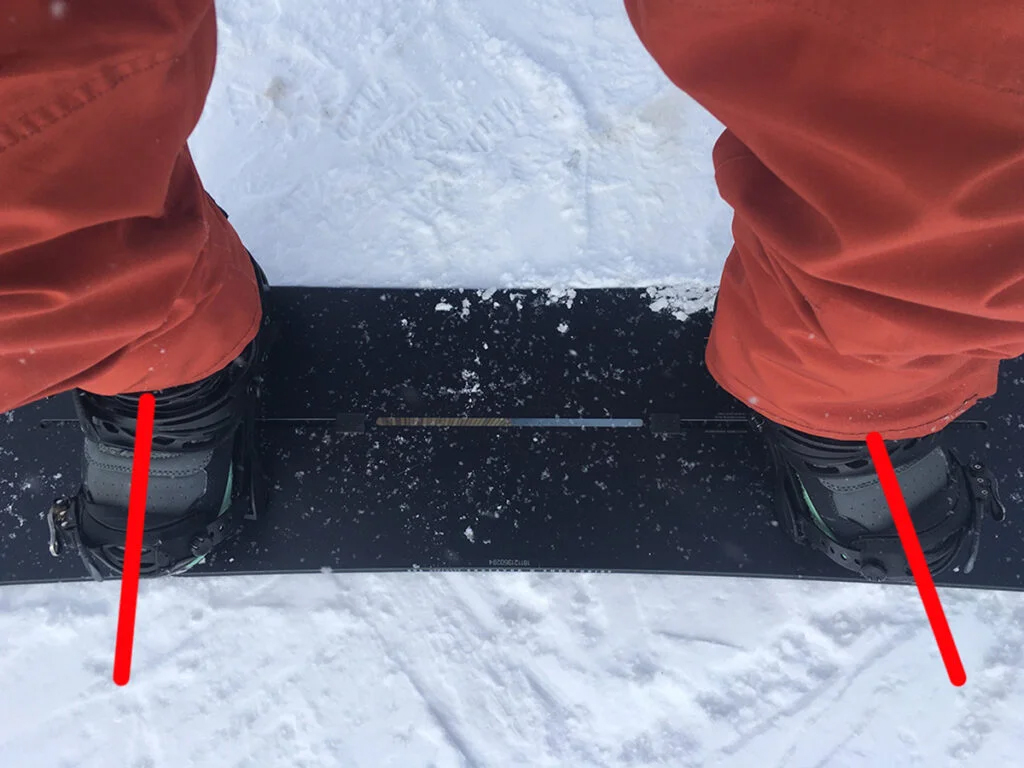
It’s a good idea to actually wear boots to set your stance!
The sense of width of the snowboarder’s stance changes with and without boots.
Therefore, we recommend that you make the final decision while wearing boots !
If you are barefoot without boots, or if you are wearing only socks, your ankles will be easier to bend than when you are wearing boots. Therefore, setting up your snowboard without boots tends to make the width wider.
However, when I put on my boots, I sometimes think, “That !? It’s quite wide.” “I thought it was just right when I wasn’t wearing boots …”
This is why the feeling of stance width that was just right when setting up in the house changed vs being on the snow.
Therefore, it is better to first make a certain amount of stance width without boots, and finally to judge the stance width with boots on.
By the way, in my own sense, when I’m barefoot, I feel that the stance width is about 56 cm.
However, when I actually wear boots, I feel that about 54 cm is just right.
I think there are individual differences, but please refer to it.
In particular, newer boots or boots with stiffer ankles will require a narrower stance.

Recommended Stance Angles for Different Snowboarding Styles
Snowboard Stance Angles
Your stance angle is as unique as your riding style! There’s no one-size-fits-all, but riders often adjust their angles to match their preferences.
Check out these recommended angles based on different snowboard styles:
Snowboard Riding Styles & Recommended Angles
- Freeriding: 18 / -6
- Powder: 21 / 0
- Park: 9 / -9
- Butter Tricks: 12 / -6
- Carving Junkie: 36 / 27

The Thinking Behind These Recommended Angles
For Freeriding, I focused on making the stance as natural as possible for the body, allowing riders to glide for long periods without getting tired. By setting the front foot at a greater angle, it makes it easier to ride forward, and the -6-degree rear foot stance also supports switch riding.
For Powder, I primarily considered forward riding. By angling the front foot, it allows for quicker turns in the trees as well.
For Park, since switch riding happens frequently, I set both the front and rear angles to the same.
For Butter Tricks, the thought process is similar to Park, but I set a slightly more forward stance to allow for tricks after more aggressive, high-speed riding.
For Carving Junkie, this is for those who truly love carving turns. I’ve suggested aggressive angles similar to those of Japanese demo riders.
Let’s refer to the stance width and angle of professional snowboarders around the world!
If you can see it on your smartphone such as an iPhone, you can easily see the table below by laying it sideways.
Men’s Pro Riders Stances & Bindings Angles
| Rider | Height | Weight | R or G stance | Stance Width | Front Angles | Back Angles |
| Ryo Aizawa | Regular | 20.5in (52cm) | 9 | -12 | ||
| Kevin Backstrom | Regular | Whatever feels good | 15 | -12 | ||
| Geoff Brown | 182cm | 72kg | Regular | 57cm | 18 | -21 |
| Danny Davis | 175cm | Regular | 23in (58.5cm) | 9 | -9 | |
| Victor de Le Rue | 5’8″ (175cm) | Regular | 22in (56cm) | 15 | 3 | |
| Miles Fallon | Regular | 20in | 15 | -3 | ||
| Tadashi Fuse | 168cm | 67kg | Goofy | 22in (56cm) | 12 | 0 |
| Terje Haakonsen | 5’8″ (173cm) | 74kg | Regular | 22in (56cm) | 21 | 6 |
| Kazunori Hirama | Regular | 23.6in (60cm) | 36 | 27 | ||
| Ayumu Hirano | 5’5″ (165cm) | 110lbs (50kg) | Goofy | 20.5in (52cm) | 16 | -6 |
| Kaishu Hirano | 166cm | 60kg | Goofy | 50.5cm | 15 | -10 |
| Ruka Hirano | 166cm | 64kg | Regular | 53cm | 15 | -9 |
| Torstein Horgmo | 5’8″ (173cm) | Regular | 21-22in(53.3〜55.9cm) | 15 | -3 | |
| Bryan Iguchi | Goofy | 21.5in | 17 | -6 | ||
| Scotty James | 6’1″ (185cm) | 165lbs (75kg) | Regular | 12 | -9 | |
| Jeremy Jones | 5’8″ (173cm) | Goofy | 22in (56cm) | 27 | 0 to 6 | |
| Yuki Kadono | Regular | 21.7in (55cm) | 6 | -9 | ||
| Raibu Katayama | 165cm | 65kg | Regular | 52cm | 6 | -3 |
| Marcus Kleveland | 5’10″(178cm) | Goofy | 22in (56cm) | 7 | -3 | |
| Kazuhiro Kokubo | 5’5″ (164cm) | 54kg | Regular | 22in (56cm) | 15 | -15 |
| Hiroaki Kunitake | 165cm | 61kg | Goofy | 48cm | 6 | -6 |
| Arthur Longo | Regular | 20.5in | 12 | -6 | ||
| Mark McMorris | 5’10″(178cm) | Regular | 23in(59cm) | 13 | -12 | |
| Takaharu Nakai | 164cm | 58kg | Regular | 54cm | 21 | 0 |
| Gigi Rüf | Regular | 22.8in | 18 | 3 | ||
| Yuto Totsuka | 170cm | 69kg | Regular | 22in (56cm) | 18 | -12 |
| Ryoki Ogawa | 167cm | 57kg | Regular | 54cm | 12 | -3 |
| Mike Rav | Regular | 21in | 7 | -3 | ||
| Travis Rice | 6’0″(183 cm) | Goofy | 22 3/4in to 23 1/2in | 18 | -6 | |
| Stale Sandbech | Goofy | 22.5in | 15 | -12 | ||
| Scott Stevens | Regular | 22.5in | 18 | -6 | ||
| Shaun White | 5’9″(175 cm) | 152 lbs(69 kg) | Regular | Between 22″ and 25″ | 12 | -3 |
Women’s Riders Stances & Bindings Angles
| Rider | Height | Weight | R or G stance | Stance Width | Front Angles | Back Angles |
| Jamie Anderson | 5’3″(160cm) | 54kg | Regular | 21in (53cm) | 9 | -9 |
| Mia Brookes | Regular | 19in | 12 | -6 | ||
| Kelly Clark | Regular | 21in | 21 | -6 | ||
| Anna Gasser | 5’5″ (165cm) | 52kg | Goofy | 22in (56cm) | 12 | -12 |
| Yuka Fujimori | Regular | 48cm | 10 | -14 | ||
| Elena Hight | 5’1″ (155cm) | Regular | 19.5in (49.5cm) | 18 | 0 | |
| Henna Ikola | Goofy | 19in | 6 | -6 | ||
| Chloe Kim | 5’3″(160cm) | 52kg | Goofy | 21in (53cm) | 15 | -12 |
| Jess Kimura | Regular | 22in (56cm) | 15 | -9 | ||
| Kokomo Murase | 155cm | 49kg | Regular | 48cm | 9 | -12 |
| Miyabi Onitsuka | 158cm | 47kg | Regular | 52cm | 15 | -15 |
| Zoi Sadowski-Synnott | 5’5″(165cm) | Regular | 21 | -9 | ||
| Aya Sato | 158 | Regular | 50.5 | 21 | -3 |
Reference Websites: Union Bindings, Jones Snowboards
Reference Book: SNOWBOARD BEST GEAR CATALOG 2024-25, September 2024 issue, Freerun Special Edition
Additionally, I checked the broadcasts of the X GAMES.
I also directly confirmed with the pro rider.
Since the materials may be outdated, please consider them as references only.



